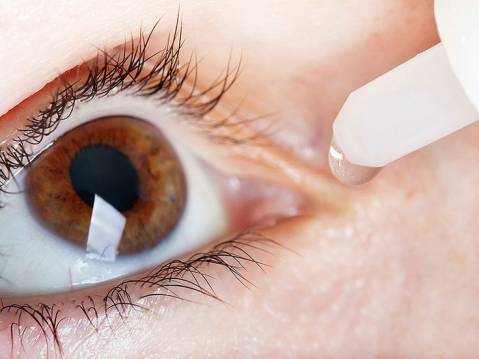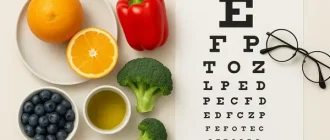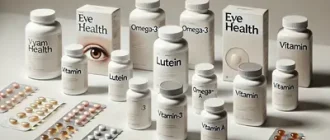If you’ve ever found yourself stretching your arm farther and farther just to read a restaurant menu or a text message, welcome to the club of over 128 million Americans dealing with presbyopia (age-related difficulty focusing up close). Until recently, the standard fixes were reading glasses, bifocals, or costly surgeries. But in 2025, a new game-changer hit the scene: VIZZ (aceclidine ophthalmic solution 1.44%), the first FDA-approved once-daily eye drop for presbyopia. This innovative treatment is already making headlines as a potential everyday solution for millions who want clearer near vision without the hassle of glasses.
What Exactly Is Presbyopia?
Presbyopia is not a disease but a natural part of aging. Starting in the early to mid-40s, the eye’s lens loses flexibility, making it harder to focus on objects up close. In the United States, it affects about 128 million adults over age 40, and worldwide, more than 1.8 billion people live with this condition ⧉. Common symptoms include needing brighter light to read, blurred vision at normal reading distance (about 16 inches/40 cm), eye strain, and headaches.
In everyday life, presbyopia can be a real nuisance. Imagine trying to check your phone in dim light or struggling to read labels at the grocery store—frustrations that pile up quickly. Until now, the go-to solutions were “cheaters” (reading glasses), multifocal contact lenses, or surgical interventions like lens implants. VIZZ introduces a non-invasive, flexible alternative that aligns well with busy, tech-driven lifestyles.
Why Is VIZZ Making Headlines?
The excitement around VIZZ isn’t just hype—it’s history in the making. Approved by the U.S. Food and Drug Administration (FDA) in mid-2025 ⧉, VIZZ stands out as the first once-daily drop designed specifically for presbyopia. Unlike older options, it doesn’t rely on magnification or invasive surgery. Instead, it leverages the eye’s natural mechanics by gently constricting the pupil. This creates what’s known as the “pinhole effect,” sharpening depth of focus and improving near vision while maintaining distance clarity.
Americans are particularly intrigued because VIZZ is positioned as an easy-to-use, lifestyle-friendly treatment. It’s as simple as adding one drop in each eye before starting the day—no glasses to carry around, no lenses to clean, no long recovery times. In a culture where convenience is king, VIZZ fits right in.
How Do VIZZ Eye Drops Work?
The active ingredient in VIZZ is aceclidine 1.44%, a muscarinic receptor agonist. In plain English, it works by contracting the iris sphincter muscle, reducing pupil size. This creates a “natural camera aperture” that enhances depth of focus. For patients, that means small print looks sharper, even in dim lighting.
Clinical data shows the onset of action begins as early as 30 minutes after administration, with effects lasting 6 to 8 hours. Unlike other presbyopia drops, VIZZ is designed for once-daily use, offering consistent vision improvement throughout a typical workday. For adults juggling meetings, school drop-offs, or just a night out, this means freedom from constantly reaching for reading glasses.
Clinical Trials and FDA Approval
The FDA’s approval of VIZZ was based on rigorous phase 3 clinical trials involving more than 600 adults with presbyopia aged 40–65. Results showed significant improvement in near vision, measured by the ability to read three or more additional lines on a standardized eye chart ⧉. Importantly, patients maintained their distance vision, a key factor in safety and daily function.

Side effects were generally mild and temporary. The most commonly reported were headache, eye redness, and temporary dimness in low light. Less than 5% of participants discontinued the treatment due to side effects, indicating high tolerability.
How Does VIZZ Compare to Other Options?
Glasses and Contact Lenses
Reading glasses are the most affordable and immediate solution, typically costing between $10 and $50. Contact lenses, such as multifocal designs, range from $250 to $700 annually. Both options, while effective, require ongoing maintenance and can be inconvenient.
Surgical Options
Procedures like LASIK, corneal inlays, or lens replacement surgery can provide long-term solutions. However, they involve higher costs (ranging from $2,500 to $4,000 per eye) and potential surgical risks. Many patients are hesitant to undergo irreversible procedures for a condition that could be managed non-invasively.
Other Eye Drops
Prior to VIZZ, the main pharmaceutical option was Vuity (pilocarpine 1.25%), approved in 2021. Vuity requires twice-daily dosing and often causes more pronounced dimming in low-light settings. VIZZ’s once-daily dosing and favorable safety profile set it apart as the next-generation therapy ⧉.
| Option | Effectiveness (Scale 1–10) | Duration of Effect | Average Cost in U.S. |
|---|---|---|---|
| Reading Glasses | 7 | Continuous | $10–50 |
| Multifocal Contacts | 8 | Daily | $250–700/year |
| LASIK/Lens Surgery | 9 | Permanent | $2,500–4,000/eye |
| Vuity Drops | 7 | 4–6 hours | ~$80/bottle |
| VIZZ Drops | 8.5 | 6–8 hours | $80–120/bottle |
Cost and Accessibility in the U.S.
VIZZ is expected to retail between $80 and $120 per bottle, which typically lasts one month with daily use. It will be available in major U.S. pharmacies and through authorized online platforms starting Q4 2025 ⧉. Unlike surgery or custom lenses, VIZZ offers a middle ground—effective, non-invasive, and reasonably priced.
For busy Americans balancing work, family, and social life, that’s a huge plus. No more keeping track of glasses at every corner of the house or committing to an expensive procedure.
Real Patient Stories
A 52-year-old man from Houston, Texas, who participated in the trial, shared that VIZZ allowed him to “finally read a menu in a dim restaurant without fumbling for glasses.” A 48-year-old woman from San Diego, California, noticed improvement within 45 minutes of the first drop: “By the time I logged into Zoom, I didn’t need my readers.” Both mentioned minor side effects—slight headache and mild redness—that faded within hours.
Another patient, a 60-year-old teacher from New York, reported that VIZZ gave her the confidence to lecture without worrying about swapping glasses. These real-world experiences highlight the practical benefits and minimal drawbacks of the new treatment.
What Do Experts Say?
Ophthalmologists across the U.S. are optimistic. Dr. Laura Periman, a Seattle-based specialist, has described VIZZ as a “meaningful advance that balances efficacy and convenience.” Experts caution, however, that patients with glaucoma or elevated intraocular pressure should consult their doctors before starting.
Reyus Mammadli, medical consultant, emphasizes: “VIZZ should be prescribed and monitored by an ophthalmologist. While it offers a convenient solution, patients with pre-existing eye conditions must use it under medical supervision.” His advice underscores the importance of individualized care.
Future of Presbyopia Treatment
VIZZ represents just the beginning of pharmaceutical innovation for age-related vision problems. Researchers are exploring combination therapies, next-generation muscarinic agonists with fewer side effects, and even sustained-release implants for long-term correction. Artificial intelligence-driven diagnostics may also play a role in customizing treatments based on individual eye structure and response ⧉.
The future looks promising for patients who want flexibility and freedom from constant dependence on corrective lenses.
Editorial Advice
For adults between 40 and 65 struggling with presbyopia, VIZZ offers a practical, non-invasive option worth considering. It won’t eliminate the condition, but it can significantly reduce the daily frustrations of blurred near vision. Always use VIZZ under the guidance of an eye specialist, especially if you have other eye conditions.
Reyus Mammadli, medical consultant, reminds: “Think of VIZZ as a powerful tool, not a magic cure. Combine it with healthy vision habits—regular check-ups, proper lighting, and protective eyewear—for best results.”
From the editorial team: If you’re tired of juggling glasses or hesitant about surgery, VIZZ might just be the fresh start your eyes have been waiting for. With its FDA approval, once-daily dosing, and growing availability, it’s positioned to change the way America sees presbyopia—literally and figuratively.





